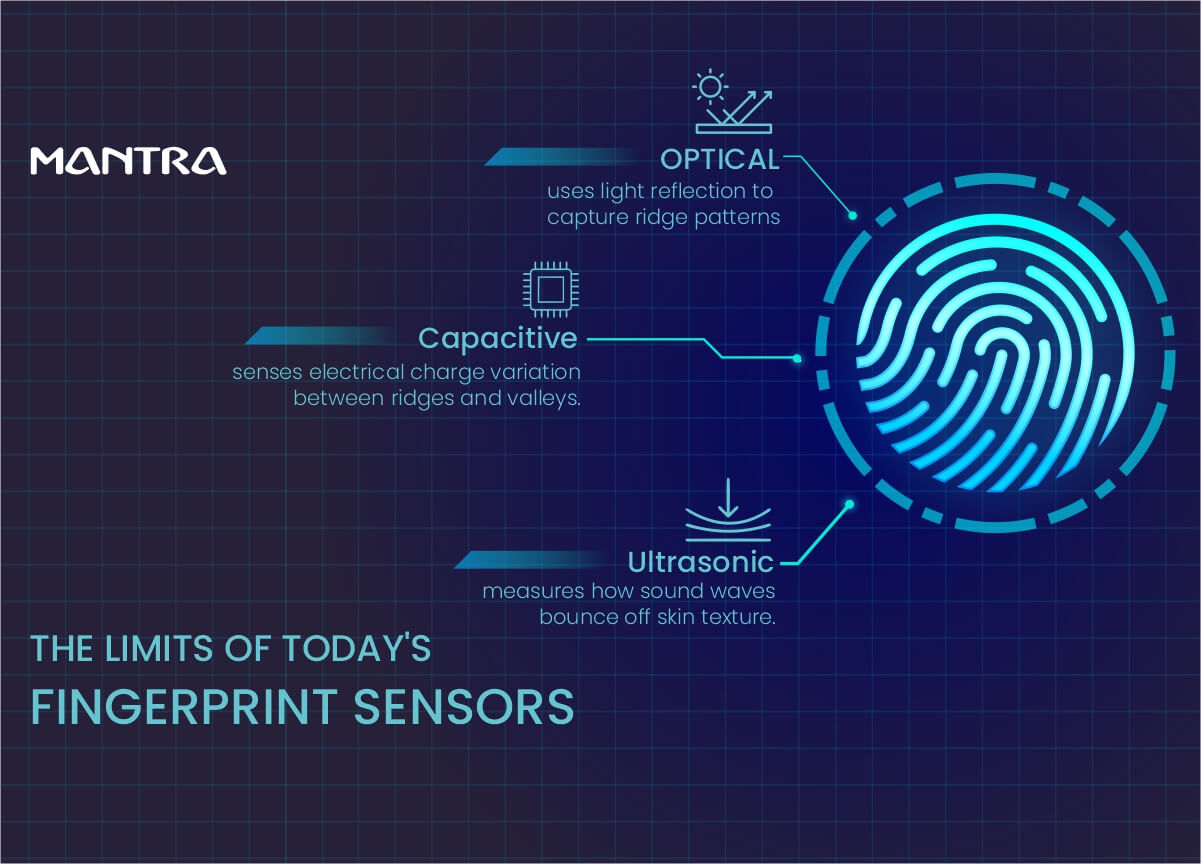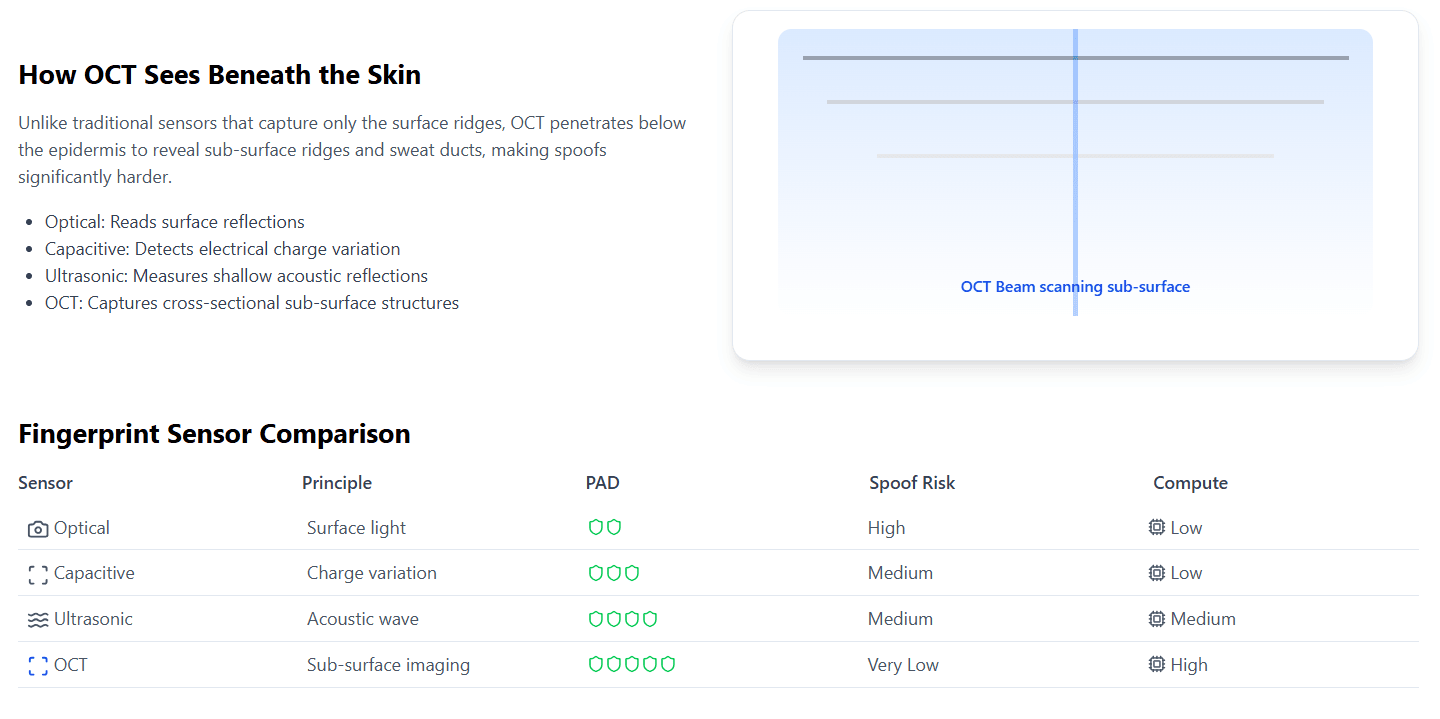
Introduction
Optical Coherence Tomography (OCT) is an advanced imaging technology that captures sub-surface ridge and tissue structures image of a fingerprint from beneath the surface of the skin. This allows it to detect spoofs that bypass optical, capacitive, or ultrasonic sensors. OCT offers the strongest Presentation Attack Detection (PAD) efficacy today, though it requires more compute and advanced optics. Originally developed for medical imaging, particularly for detailed eye scans in ophthalmology, OCT is now being applied to biometrics to create a new frontier in security and liveness detection.
The Limits of Today's Fingerprint Sensors
Fingerprint recognition has been the backbone of biometric authentication for two decades. From smartphones to door locks, three main sensor types dominate:
Optical – uses light reflection to capture ridge patterns.
Capacitive – senses electrical charge variation between ridges and valleys.
Ultrasonic – measures how sound waves bounce off skin texture.
While each has merits—fast, compact, inexpensive—they all share a critical weakness: surface-level imaging.
Spoofing Weakness
Attackers exploit this by creating presentation attacks: high-resolution prints, thin conductive films, silicone molds, or 3D-printed replicas. Once placed on the sensor, these fakes mimic surface ridge details convincingly.
Even advanced ultrasonic sensors, which probe slightly below the surface, still miss deeper biological structures that prove a fingerprint belongs to a live human being.
With the rise of ISO/IEC 30107 PAD testing (Levels 1–3), it's clear that most mainstream sensors can pass basic attacks (L1) but falter against sophisticated composite spoofs (L2/L3). Enterprises, airports, and defense applications require more.
Enter OCT: Fingerprints in 3D, Beneath the Surface
Optical Coherence Tomography (OCT), long trusted in medical imaging (especially ophthalmology), now moves into biometrics. Unlike standard imaging that captures a 2D surface, OCT generates cross-sectional 3D scans of skin microstructure—a "fingerprint MRI" of sorts.
Here's why OCT is a game-changer:
Sub-surface ridges: OCT detects dermal and sub-dermal ridge structures invisible to spoofs.
Sweat ducts & tissue patterns: These natural anatomical markers cannot be cloned by silicone or printed overlays.
Dynamic signals: OCT can pick up subtle blood perfusion or micro-sweating—biological liveness cues.
Anti-spoof by design: A latex mold may replicate surface ridges, but it cannot mimic multi-layer tissue scatter patterns.
In essence: OCT looks beyond the "stamp" of a fingerprint to the living tissue beneath.
Comparing Sensor Physics & PAD Efficacy
Let's break down the differences:
| Sensor Type | Physics Principle | PAD Efficacy | Vulnerable To | Compute Needs | Typical Use Cases |
|---|---|---|---|---|---|
| Optical | Light reflection from ridges | Low–Medium | Printed/gel images | Low | Phones, door locks |
| Capacitive | Electrical charge variation | Medium | Conductive films, thin silicone | Low | Smartphones, IoT devices |
| Ultrasonic | Acoustic waves penetrating ~200–300 µm | Medium–High | Advanced elastomer molds | Medium | Rugged phones, defense |
| OCT | Interference imaging of tissue layers (0.5–2 mm depth) | Very High | Still being tested (requires highly complex spoofs) | High | Borders, defense, enterprise security |
Key Differentiator
Whereas others depend on 2D surface-level contrast, OCT builds a 3D biometric signature—layered depth data plus temporal liveness signals. This raises the attack difficulty from "high school lab" to "specialized medical fabrication."


Compute & Deployment Considerations
OCT's strengths come at a cost. Deployers should weigh:
Processing requirements: OCT images are more data-rich than capacitive or optical scans. On-device AI accelerators or edge compute units are often necessary.
Hardware size & cost: OCT optics are bulkier and pricier, though miniaturization is accelerating.
Throughput: Real-time capture and classification require optimized pipelines to match the speed expectations of biometric verification ( <1 second).
Energy efficiency: For mobile or IoT use cases, power-hungry OCT may be limiting—currently more suited to fixed security checkpoints.
OCT and ISO/IEC 30107 PAD Compliance
In biometric procurement, buyers often see "iBeta PAD certified" labels. But not all PAD claims are equal.
Level 1 (L1): Basic spoofs (printed images, gummy fingers).
Level 2 (L2): Skilled fakes using higher-grade materials.
Level 3 (L3): Advanced, lab-grade spoofs, often using cooperative subjects' latent or lifted prints.
While optical and capacitive sensors may pass L1, and ultrasonic may pass L2, OCT is uniquely positioned to tackle L3—thanks to its sub-surface and dynamic tissue imaging.
For buyers, this matters: PAD level directly maps to real-world spoof resistance.
Where OCT Will Make the Biggest Impact
Unlike traditional fingerprint sensors that only see the 2D surface pattern of ridges and valleys, an OCT scanner works like a "fingerprint MRI." It penetrates the outer layer of skin to map the unique and complex structures of the living tissue below.
This sub-surface approach makes OCT a game-changer for several reasons:
Border Control & Immigration – Automated border kiosks must resist L2/L3 spoofs, especially against organized crime.
Defense & Aerospace – Secure facilities cannot afford false accepts from fake biometrics.
Financial Services – OCT-enabled kiosks may provide safer ATM access or high-value transaction approvals.
Enterprise Security – Critical infrastructure operators (energy, telecom) are piloting OCT as a safeguard against insider spoof attempts.
In short, OCT fingerprint scanning captures a rich, 3D biometric signature from living tissue, setting a new and significantly higher standard for anti-spoofing and authentication trust.
Fast-Start Checklist for OCT Adoption
If you're evaluating OCT biometrics:
Define your risk level: What class of attacker (casual, skilled, or lab-grade) do you need to block?
Request vendor demos: Insist on PAD test reports (ISO/IEC 30107) with L2/L3 spoofs.
Check compute integration: Can your system handle OCT's data flow, or do you need AI co-processors?
Pilot where risk is highest: Start with border gates, server room doors, or data centers.
Future-proofing: OCT offers not just spoof resistance, but also biometric longevity—since sub-surface traits age more slowly than surface ridges.
Conclusion
Fingerprint recognition is at a crossroads. Optical, capacitive, and ultrasonic sensors remain adequate for convenience, but in an era of AI-driven spoofing and 3D printing, they show cracks at higher threat levels.
OCT fingerprint imaging marks the new frontier. By revealing sub-surface structures and capturing liveness cues no replica can match, OCT sets a new benchmark for trust in biometrics. While compute and cost remain challenges, its adoption in border security, defense, and high-value enterprise access signals the future of anti-spoof authentication.
Comments